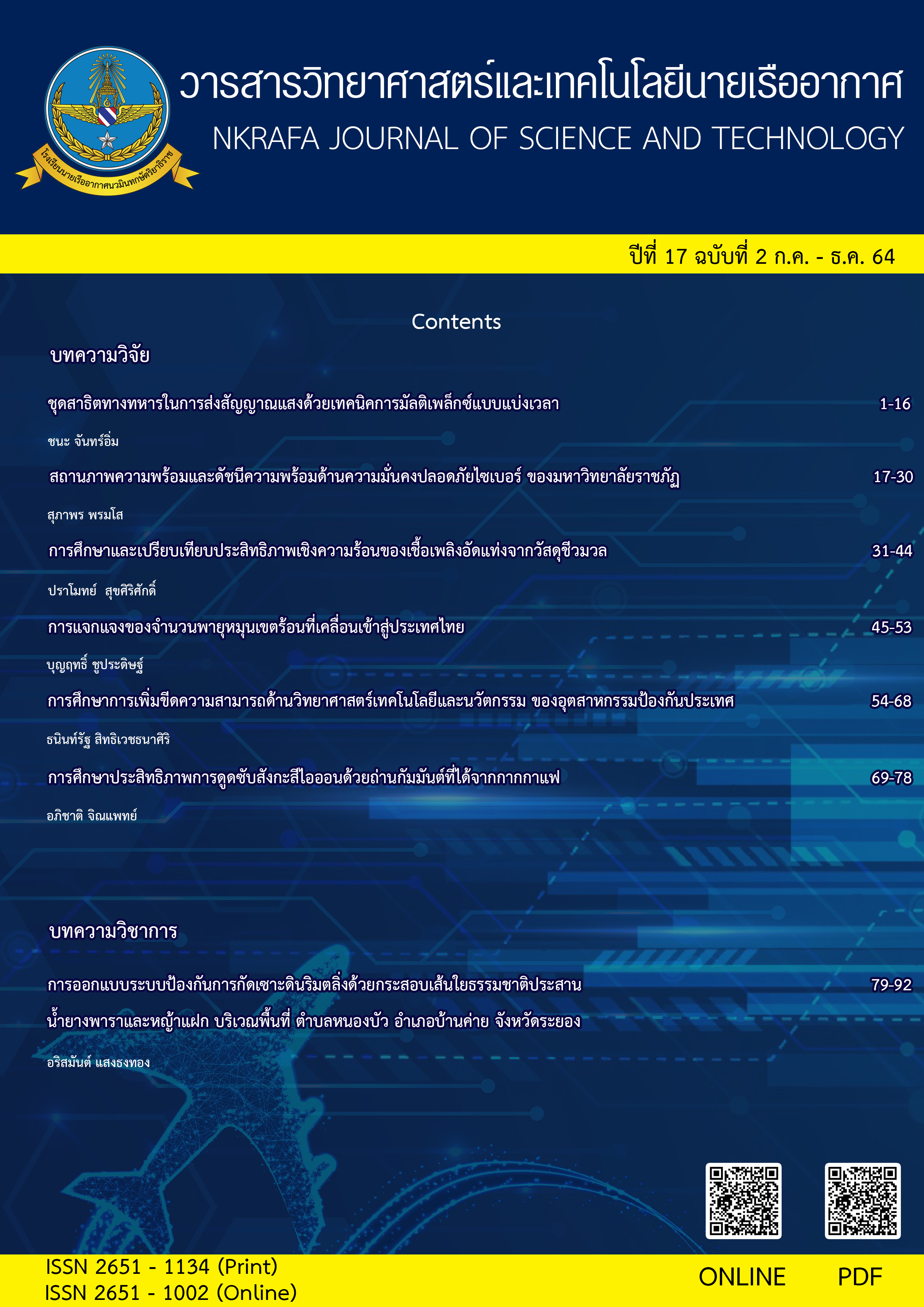A study of science, technology and innovation enhancement for defense industry
Main Article Content
Abstract
This research aimed to study the technology capability and skill of the Thai defense Industry. The study's objectives included the needs of entrepreneurs in developing manpower in terms of knowledge and essential skills by presenting in the form of a roadmap to increase the scientific capacity, technology, and innovation of the national defense industry. The results from in-depth interviews with the executives found the highest capacity of the technology capability of Thailand's defense industry was the building of ships industry, which government agencies work with the private sector from abroad. Besides, the technology capability needed to be promoted consists of robotics and artificial intelligence (AI), based on the same military standards as the aviation industry. In addition, development needs showed that it is necessary to urgently develop people's knowledge and skills from educational institutions through the Offset Policy. The development must focus on specific skills at the bachelor's degree or lower so that people can work in the groups of weapons ammunition and explosives industry, automotive industry, marine industry, aerospace industry, information and communication technology, training aid, and disaster prevention and mitigation equipment. Furthermore, the experts focused on strengths, weaknesses, opportunities, and obstacles to developing science, technology, and innovation by employing a hierarchical analysis process (AHP: Analytic Hierarchy Process) to formulate a strategy based on the TOWS Matrix generation. This strategy will be used to formulate policies and plans to develop the defense industry in the future.
Article Details

This work is licensed under a Creative Commons Attribution-NonCommercial-NoDerivatives 4.0 International License.
- Content and information in articles published in NKRAFA Journal of Science and Technology are comment and responsibility of authors of articles directly. Journal editorial do no need to agree or share any responsibility.
- NKRAFA Journal of Science and Technology Articles holds the copyright of the content, pictures, images etc. which published in it. If any person or agency require to reuse all or some part of articles, the permission must be obtained from the NKRAFA Journal of Science and Technology.
References
จุฬาลักษณ์ กองเพชร. (2559). การประยุกต์ใช้กระบวนการลำดับชั้นเชิงวิเคราะห์ในการคัดเลือกบรรจุภัณฑ์ของบริษัทผลิตเลนส์และกล้องถ่ายรูป. การค้นคว้าอิสระหลักสูตรวิศวกรรมศาสตรมหาบัณฑิต สาขาวิชาการพัฒนางานอุตสาหกรรม ภาควิชาวิศวกรรมอุตสาหการ คณะวิศวกรรมศาสตร์ มหาวิทยาลัยธรรมศาสตร์.
ดนัยศักดิ์ หงส์พันธุ์. (2560). การประยุกต์ใช้กระบวนการวิเคราะห์เชิงลาดับชั้นสาหรับการเลือกสถานที่ตั้งรีสอร์ทในเขตอำเภอเมือง จังหวัดจันทบุรี. วิทยานิพนธ์หลักสูตรวิศวกรรมศาสตรมหาบัณฑิต สาขาวิชาการบริหารงานก่อสร้างและสาธารณูปโภค มหาวิทยาลัยเทคโนโลยีสุรนารี.
นพรัตน์ นุ่มศิริ. (2564). การตัดสินใจเลือกรูปแบบในการจัดการมูลฝอยของกองทัพอากาศ ณ ที่ตั้งดอนเมือง. วารสารวิทยาศาสตร์และเทคโนโลยีนายเรืออากาศ. ปีที่ 17 ฉบับที่ 1 มกราคม - มิถุนายน 2564.
แผนปฏิบัติการด้านการพัฒนา วิทยาศาสตร์ เทคโนโลยีอุตสาหกรรมป้องกันประเทศ (พ.ศ. 2563 -2580) กระทรวงกลาโหม.
ยุทธศาสตร์การพัฒนาวิทยาศาสตร์ เทคโนโลยี อุตสาหกรรมป้องกันประเทศกระทรวงกลาโหม พ.ศ.2560 – 2579 (ฉบับเผยแพร่).
รัฐรุจน์ ฐิติชาติธนวงศ์. (2557). การจัดลำดับปัจจัยความสำคัญในการคัดเลือกเครื่องจักรโดยใช้กระบวนการวิเคราะห์เชิงลำดับชั้น กรณีศึกษาโรงผลิตเครื่องประดับ. วิทยานิพนธ์หลักสูตรวิศวกรรมศาสตรมหาบัณฑิต สาขาวิชาวิศวกรรมอุตสาหการ มหาวิทยาลัยเทคโนโลยีราชมงคลธัญบุรี.
วิษณุ มั่งคั่ง. (2560). แนวทางการพัฒนาอุตสาหกรรมป้องกันประเทศภายใต้กรอบยุทธศาสตร์ชาติ 20 ปี. วารสารสถาบันวิชาการป้องกันประเทศ. ปีที่ 8 ฉบับที่ 1 มกราคม - เมษายน 2560.
พลตรีเอกชัย หาญพูนวิทยา. (2560). เอกสารวิจัยวิทยาลัยป้องกันราชอาณาจักร เรื่อง การขับเคลื่อนกิจการอุตสาหกรรมป้องกันประเทศของประเทศไทยให้เป็นรูปธรรม.
Shinno, H., Yoshioka, H., Marpaung, S., and Hachiga S. (2006). Quantitative SWOT analysis on global competitiveness of machine tool industry. Journal of Engineering Design. Vol.17. pp. 251-258.
Mofofeng, T. & Mativenga, P.T., (2020). Analysis of aircraft maintenance processes and cost, Procedia CIRP. 90. 467-472.
Saaty, T. L. 1980. The Analytic Hierarchy Process. McGraw-Hill,New York.
Kusonwattana, P., Liangrokapart, J. "Efficiency Enhancement in Rail Freight Service in Thailand Using Servqual Model". 2020 IEEE 7th International Conference on Industrial Engineering and Applications (ICIEA), Bangkok, Thailand, 2020, pp. 847-853, doi: 10.1109/ICIEA49774.2020.9102020.
Raka C., Liangrokapart J. (2017). An Analytical Hierarchy Process (AHP) Approach to Risk Analysis: A Case Study of a New Generic Drug Development Process. Journal of Pharmaceutical Innovation, 12, p. 319-326.
Nitisaroj, Y., Liangrokapart, J. (2020). Third party logistics providers: Sustainability performance measurement framework. International Journal of Logistics Systems and Management, 37(3), pp. 352–370.


